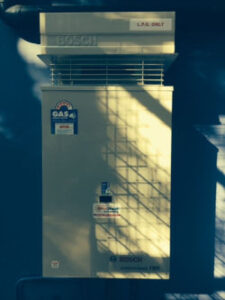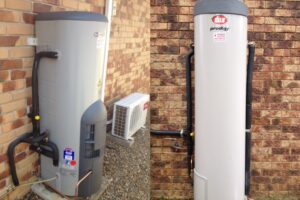With so many hot water system types, sizes, and models available it can be difficult to know which system is best suited to your needs. However, below we have gathered information on each type of electric hot water system to make the decision easier. If you’re not sure which hot water system is right for you call your local hot water experts.
Sun City Hot Water & Plumbing have been specialising in hot water systems Brisbane North & Sunshine Coast for over 20 years. Call us today on 1300 728 122 for expert advice, and quality hot water system installations, repairs and servicing on every type of hot water system.

Types Of Electric Hot Water Systems
Electric hot water systems are very popular in Australia as generally, all houses use electricity. There are two main types of electric hot water systems available; continuous flow hot water systems and storage hot water systems.
Continuous Flow Electric Hot Water System
Continuous flow hot water systems (also known as instantaneous or tankless systems) are less common than their storage counterparts. As the name suggests, this system is designed to provide a continuous flow of hot water rather than heating and storing. This means that continuous flow hot water systems don’t require a storage tank, making the system a lot smaller. In fact, a continuous flow electric hot water system is roughly the size of a small suitcase and is generally wall mounted.
In a continuous flow hot water system, when a hot water outlet is turned on the system is activated, heating the water before it reaches the outlet. This allows the system to provide a “continuous flow†of hot water throughout the entire day, rather than being limited to the amount of pre-heated water available.
One consideration of continuous flow hot water systems is that they generally require high power inputs, especially if there are multiple systems running simultaneously.
Electric Storage Hot Water System
In an electric storage hot water system, water is heated to the preset temperature by one or two electric elements in the storage tank. The water hot water is then stored in the tank until needed. As the water in the tank is heated, the hot water rises to the top. When a hot water outlet is turned on, water is then drawn from the top of the tank to ensure the hot water is used first.
However, as the water is stored, heat is lost through the walls of the tank. Additionally, as hot water is drawn from the tank to be used, new cold water is circulated into the tank, dropping the overall water temperature. When the thermostat detects that the water temperature has dropped, the heating elements are activated in order to bring the water back up to the desired temperature.
Conversely, if the water temperature or pressure in the tank is too high, water is released through a pressure/temperature relief valve.
Other Types of Electric Storage Hot Water Systems:
Off-Peak Electric Storage Hot Water Systems
An off-peak storage hot water system is similarly set up with a storage tank and two electric elements. However, as the name suggests, an off-peak system only heats water during off-peak tariffs in order to reduce running costs.
Off-peak electric storage hot water systems generally come with a larger storage tank. This is because the water is only heated overnight, unlike standard storage systems that can heat new tanks of water at any time of the day.
Most off peak systems have a secondary heating element near the top of the tank that is used to maintain the water temperature as it drops throughout the day, leaving the main heating element to run on off-peak tariffs overnight. Additionally, each element has its own thermostat that can be set to different temperatures to further reduce heating costs during peak electricity tariffs.
Electric Booster Hot Water System:
Electric storage hot water systems can also be used to supplement a solar hot water system. As a solar hot water system is somewhat reliant on weather, they work best with a booster system to heat water when the weather doesn’t allow for the solar system to work effectively.
How Do Electric Hot Water Systems Work?
Continuous Flow Electric Hot Water System
There are three main components in an electric continuous flow hot water system:
- Electric Heating Element
- Heat Exchanger
- Thermostat

In an electric continuous flow hot water system, there is no storage tank as the water is heated as needed. Once a hot water outlet is turned on, the running water triggers a flow sensor which activates the hot water system. Once the system is activated, the heating element heats the coiled copper pipes of the heat exchanger. As the water is circulated through these pipes it is heated to the desired temperature and then circulated back out to the hot water outlet.
Once the outlet has been switched off, the flow sensor will detect that there is no more water, causing the heating element to switch off.
Electric Storage Hot Water System
An electric storage hot water system is made up of the following four main components:
- Electric Heating Element
- Storage Tank
- Pressure/Temperature Relief Valve
- Thermostat

The heating in the hot water system is activated when the thermostat detects that the temperature of the water has dropped below the preset temperature. The heating element (located at the bottom of the tank) will then heat the water similarly to the way water is heated in a kettle until the set temperature is reached. This continues throughout the day to ensure that the desired water temperature is maintained as heat is lost through the walls of the tank.
Conversely, in an off-peak hot water system, there is a secondary element near the top of the tank that is used to maintain the water temperature. This element is generally smaller than the main heating element at the bottom of the tank that is only activated during off-peak tariffs.
In both types of electric storage hot water systems, when a hot water outlet is turned on, the water is drawn from the top of the tank. This is because hot water rises to the top of the tank ensuring that the water that comes out of the outlet is still hot, even when new water is added to the tank to be heated. There is also a pressure/temperature relief valve that is used to release small amounts of water from the tank when the water temperature exceeds the preset temperature.
Electric Storage vs. Continuous Flow Electric Hot Water Systems
| Electric Storage Hot Water | Electric Continuous Flow Hot Water |
 Small storage tank hot water systems can start from only $200 Small storage tank hot water systems can start from only $200 |  The average minimum price of a continuous flow electric hot water system is $660+ The average minimum price of a continuous flow electric hot water system is $660+ |
 This system is one of the least energy efficient hot water systems available due to heat loss throughout the day This system is one of the least energy efficient hot water systems available due to heat loss throughout the day |  This system is energy efficient as water is heated on demand rather than constantly using energy to maintain water temperature This system is energy efficient as water is heated on demand rather than constantly using energy to maintain water temperature |
 Expected lifetime of 10 – 12 years Expected lifetime of 10 – 12 years |  Expected lifetime of up to 20 years Expected lifetime of up to 20 years |
 Warranty can range from 5 to 10 years Warranty can range from 5 to 10 years |  Warranty will generally be between 10 and 12 years Warranty will generally be between 10 and 12 years |
 The amount of hot water available at any one time is limited to the size of the tank The amount of hot water available at any one time is limited to the size of the tank |  Unlimited hot water available as water is heated as needed Unlimited hot water available as water is heated as needed |
 Flow rate remains the same when multiple outlets are in use as water is already heated Flow rate remains the same when multiple outlets are in use as water is already heated |  Flow rate decreases when multiple outlets are in use at one time as water is split between outlets once heated Flow rate decreases when multiple outlets are in use at one time as water is split between outlets once heated |
Call A Hot Water Specialist
Not sure what size or type of electric hot water system is best for you? Call your local hot water specialists at Sun City hot Water & Plumbing. With no affiliation with any single hot water system manufacturer we can offer unbiased advice on which system will best meet your needs. Call us today on 1300 728 122 for quick response hot water system services Sunshine Coast and Brisbane north wide.





